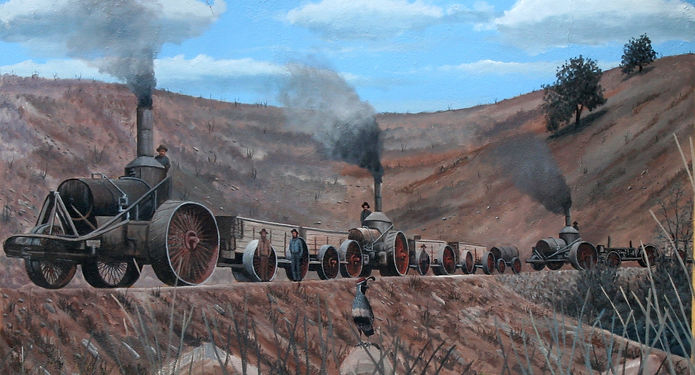13. Traction Engine Bringing Copper from Bisbee Mines to Benson Smelter c. 1887

Mural Depiction
In January 1887, the Copper Queen Mine in Bisbee tried using the Fowler steam traction engine to haul ore to Benson. It was called "Geronimo", and was capable of hauling up to 30 tons of ore daily. But it was not very efficient, as it had little traction over much of the route. When it was dry, its wheels would often spin in the sand and dust. If there was any moisture in the soil at all, the engine was made immovable.
Even if it could have traversed the 30 mile route to Tombstone, the water and fuel capacity of the engine was too limited to be effective. All was not lost however, as it was used to haul loads of copper from Bisbee nine miles over the 10% grades of Mule Pass. After surmounting the pass, the wagons were then exchanged with those being hauled by the mule and horse teams the remainder of the way to and from the railroad in Fairbank. The return trip to Bisbee would usually be loads of coal or coke destined for the mines.
Background Information
John Fowler (11 July 1826 - 4 December 1864) was an English agricultural engineer who was a pioneer in the use of steam engines for plowing and digging drainage channels. His inventions significantly reduced the cost of plowing farmland, and also enabled the drainage of previously uncultivated land in many parts of the world.
A traction engine is a self-propelled steam engine used to move heavy loads on roads, plow ground or to provide power at a chosen location. They are sometimes called road locomotives to distinguish them from railway locomotives. Traction engines tend to be large, robust and powerful, but heavy, slow, and difficult to maneuver. Nevertheless, they revolutionized agriculture and road haulage at a time when the only alternative prime mover was the draft horse or mule team.
Mural Information
Artist: Doug Quarles
Size: 4' x 8'
Completed: November 2013
Sponsors:
City of Benson
Arizona G & T Cooperatives
Sulphur Springs Valley Cooperative

